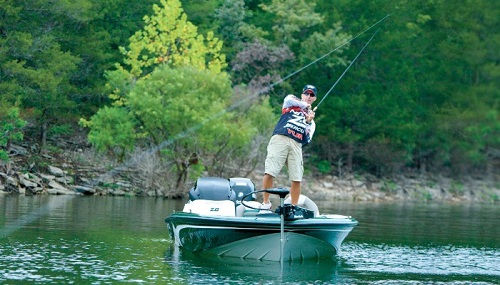 A friend of mine has a theory: any time you see the word fat or calories in an advertisement for food, just substitute the word taste and you’ll know whether it’s any good. If the ad copy says “reduced calories,” you can assume it has “reduced taste,” too.
A friend of mine has a theory: any time you see the word fat or calories in an advertisement for food, just substitute the word taste and you’ll know whether it’s any good. If the ad copy says “reduced calories,” you can assume it has “reduced taste,” too.
This is analogous in the world of fishing to words like “stretch.” In recent years, we’ve been told that braided line has “no stretch” and fluorocarbon has “minimal stretch.” We’ve held this to be a self-evident truth that they’re better than traditional monofilament.

| Edwin Evers locks into a topwater bite. The stretch of monofilament line
can provide better hook sets—especially in situations where the angler is more apt to pull the lure from the fish’s mouth. |
If you’ve read the popular fishing press, you might even have the impression that you should just throw all of your mono away, use it exclusively to hang pictures, or torch it in a huge, environmentally-unfriendly bonfire.
Don’t listen to that supposed conventional wisdom. It’s not true. There are still plenty of uses for traditional monofilament lines. Moreover, the quality of the mono on the market is better than ever. If you were catching tons of fish with the old stuff 20 years ago, before fluoro and braid entered your consciousness, it didn’t become worthless overnight.
If you don’t believe me, listen to the pros. Here are 3 reasons mono still has a place on their boat.
 |
| 10- to 17-pound test Bass Pro
Shops XPS mono is Edwin Ever’s line choice for several tactics. |
1. Mono is Easy to Use
When Bass Pro Shops pro Chris Lane won a Bassmaster Elite Series tournament on Florida’s St. Johns River last year, he fished his soft plastics on 15-pound test Stren Brute Strength Monofilament in line-chewing lily pads. He later told the media that “When it comes to end results, mono is still the best all-around line to throw. It’s the best and easiest to cast. You don’t need special knots. It’s forgiving.”
He raises key points. While braid and fluoro certainly have their time and place, they can be tricky to learn to use properly. Braid, for instance, gets wind knots and if your rod doesn’t have a bit of forgiveness, you can pull the hooks right out of a surging fish’s mouth. Fluoro, on the other hand, can be tough to control. It might billow off the spool unexpectedly or cut into itself if you use an inappropriate knot.
2. Mono is Cheap
Mono is also comparatively inexpensive. Put premium fluoro on your reel and you might try to get too much use out if it before respooling. With low-cost mono, you might be more apt to replace it at the first sign of overuse.
Nitro Pro Edwin Evers, who like Lane has a B.A.S.S. victory on the St. Johns on his list of accomplishments – along with seven other Bassmaster wins – said that there are times when monofilament remains his preferred line, not just a last-gasp choice to save a few bucks.
3. Mono Floats
“It’s mainly for topwaters,” he said. “When I’m fishing a Megabass Pop-X or Pop-Max or a little prop bait, it’s important to keep the bait up. Fluorocarbon and braid sink. For that reason I use it with my wake baits and with some swimbaits, too. When you’re fishing lures with little bitty treble hooks that can pull out and you want to keep the lure up in the water column, 10- to 17pound test Bass Pro Shops XPS mono is my line of choice for the buoyancy and that little bit of stretch.”
For the reasons that Evers stated, monofilament’s rumored disadvantages—notably stretch and the fact that it floats—can be used to put more fish in your livewell.
Ripping a lipless crankbait over super-shallow grass? Switch from 17-pound fluoro to 25-pound mono and it won’t bog down in the greenery.
Spastic smallmouths jumping at the boat and spitting your topwaters back in your face? Add a little bit of give via line with more stretch and you’ll end up with grip-and-grin pictures.
With mono, sometimes you can have your cake and eat it, too. Unlike some other fat-free products, the taste can be incredible.
This article was produced by Pete Robbins for Bass Pro Shops 1Source, where it appeared first.
By Pete Robbins -Veteran outdoor writer Pete Robbins writes primarily about bass fishing for a wide variety of magazines and websites. He has provided on-the-water tournament coverage for every Bassmaster Classic since 2010, and has been known to bring bad weather with him to venues that have not previously experienced any. He’s blogged for Gary Yamamoto’s Inside Line since 2008, where he explores issues related to fishing, food and popular culture, with a particular interest in the intersection of those three seemingly unrelated topics. He has not yet been featured on “Hoarders,” although his tackle collection is beyond extensive, with a particular focus on rare Japanese hard baits.
Pete calls the Potomac River his home water, but has made multiple trips to the Amazon in search of peacock bass, and tries to make at least one trip per year to Mexico to chase big largemouths and drink margaritas.
He lives in Vienna, Virginia with his wife Hanna and their precocious Australian Shepherd Rooster, who has been known to herd small animals and children.
